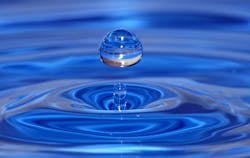Water Use Efficiency Vital for Commercial, Institutional Facilities
[Editor's note: this column originally appeared in HPAC Engineering.]
This column has often been devoted to technologies related to energy efficiency. Energy reduction is, of course, directly related to carbon reduction, and is a critical climate change mitigation strategy.
Conserving water resources is also key to any overarching sustainability plan and resonates strongly here in South Florida, where we see the effects of sea-level rise every day. Recently I had the opportunity to present at the 2021 Water Conservation Expo, hosted by the South Florida Water Management District. The following is excerpted from that presentation, which addressed water use efficiency in commercial and institutional facilities.
The question of why water conservation in commercial and institutional buildings is important is fairly obvious. A study released in 2017 by the U.S. Energy Information Administration indicated that 46,000 of the largest – which they defined as more than 200,000 square feet – commercial buildings in the U.S. used 2.3 percent of the country’s total public water supply. Now, 2.3 percent may not sound like a lot, but in 2012, that represented nearly a billion gallons of water per day.
- Listen to Larry Clark in our podcast series, HPAC On the Air.
According to that study, hospitals, correctional facilities, and hotels – in that order – were the largest water consumers and had the highest water intensity in gallons per square foot. Of course, those types of facilities – hospitals, prisons, and hotels – represent a much smaller share of the total building inventory than do commercial office buildings. A typical office building can have a water intensity which is less than a third of that of a hospital, but in the U.S., there are approximately 97 billion square feet of office buildings compared to only 2.3 billion square feet of hospitals. The EPA estimates that together, those hospitals, office buildings, and other commercial and institutional facilities use 17 percent of all publicly-supplied water in the U.S.
Interestingly, regardless of a building’s end-use, some 30 to 40 percent of the water use in buildings is typically for restrooms. So those are obviously low-hanging fruit when owners are looking for ways to conserve water. A number of state and national programs support water efficient plumbing fixtures and equipment, perhaps most notably the EPA Water Sense program. And the efficiency of these fixtures is constantly improving.
- Take our latest HPAC Monthly Quiz, celebrating Earth Day.
In 1994, 3 to 5 gallons-per-flush (gpf) toilets started being replaced with 1.6 gpf (which became mandatory for commercial buildings in 1997). By 2014, 1.28 gpf was the new standard in many jurisdictions, 1.1/1.6 gpf dual flush toilets were gaining in popularity, and today 0.5/0.8 gpf dual-flush toilets are sold on the internet. Lavatory faucets and shower heads are also much more efficient than in the past, and even simple, inexpensive faucet aerators provide tangible water savings.
Clearly, conserving water in any commercial or institutional building should start with the development of a water management plan, and should include an assessment of the building’s water use in order to identify opportunities for reducing water consumption. It should also provide a means for tracking the results of any water conservation measures that are implemented. The old saying that you can’t manage what you can’t measure definitely applies to water conservation.
Of course, many of the water conservation measures in commercial and institutional facilities are just commonsense maintenance practices, like regularly checking for leaks and promptly repairing them. Not as obvious, perhaps, are measures such as retrofitting older, less efficient, water-consuming HVAC systems and equipment.
South Florida—like other vacation destinations–has a plethora of hospitality properties, and all of those visitors want clean sheets and towels. So it’s not surprising that hotels use 16 percent of their total water consumption in their laundry operations. A full-service hotel (one with a restaurant, pool, and banquet facilities) will typically wash 12 to 14 lbs of laundry per room per day. In a resort, with golf and tennis facilities, that can jump to 16 lbs per room per day. Towel and linen reuse programs, that encourage guests to use their towels and linens more than once during their stay can save an average of 17 gallons of water per day per occupied room, while also saving electric energy and reducing detergent use
Finally, for commercial and institutional facilities seeking green building certifications, water conservation is a must. LEED, Green Globes, and others all require buildings to demonstrate significant reductions in water, either through compliance with prescriptive requirements or by demonstrating successful performance outcomes, or both.
For example, the just-released Green Globes for Existing Buildings 2021 allocates 185 out of a possible 1,000 points to water. Of those 185 points, 65 are performance-based and 120 are prescriptive.
So, even if a building isn’t seeking certification, saving water makes good sense for the planet... and good ‘cents’ for owners, too.
A regular contributor to HPAC Engineering and a member of its editorial advisory board since 2012, Clark, LEED AP, O+M, is a principal at Sustainable Performance Solutions LLC, a south Florida-based engineering firm focusing on energy and sustainability. Email him at [email protected].
